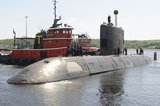Australia’s Tritons edge closer to operations as service contract signed
Australia has signed an interim support contract for Triton UAS. (Image: Australian DoD)
The reality of Royal Australian Air Force MQ-4C Tritons UAS patrolling Australia’s surrounding oceans, particularly the north-west coast, has come a step closer with the Australian Department of Defence (DoD) signing an Interim Sustainment Support Contract with Northrop Grumman.
The deal to supply the UASs has been valued at around AUD220 million (US$141 million) following the signing on 8 November.
The first of four Tritons, with ground and support systems, will be due for delivery next year. The support contract will be expected to run through until 2027, by which time it has been planned for the first aircraft to enter service, with a permanent support contract set
Already have an account? Log in
Want to keep reading this article?
More from Naval Warfare
-
![How will SAFE shape naval procurement for Canada and its highest-receiving members?]()
How will SAFE shape naval procurement for Canada and its highest-receiving members?
Canada’s inclusion on the EU’s Security Action for Europe initiative is set to enhance the country’s defence procurement strategy with important implications for some of its naval programmes, while Poland and Romania have also secured significant SAFE funding.
-
![Thales wins DE&S contract for portable autonomous command centres]()
Thales wins DE&S contract for portable autonomous command centres
The agreement to provide portable autonomous command centres to the UK Royal Navy will enhance the service’s Mine Counter Measure operations and further integrate autonomous and uncrewed systems into its fleet.
-
![US Navy to conduct an experimentation campaign with emerging tech in 2026 and 2027]()
US Navy to conduct an experimentation campaign with emerging tech in 2026 and 2027
The Technology Operational Experimentation Events will inform future requirements as the US Navy looks for innovative solutions across three key operational domains.
-
![US Navy to acquire micro-uncrewed underwater vehicles for ISR and coastal data collection]()
US Navy to acquire micro-uncrewed underwater vehicles for ISR and coastal data collection
The Naval Supply Systems Command is seeking authorised resellers of JaiaBot uncrewed underwater vehicles and multivehicle pods. The platforms will support undergraduate education at the US Naval Academy.






















